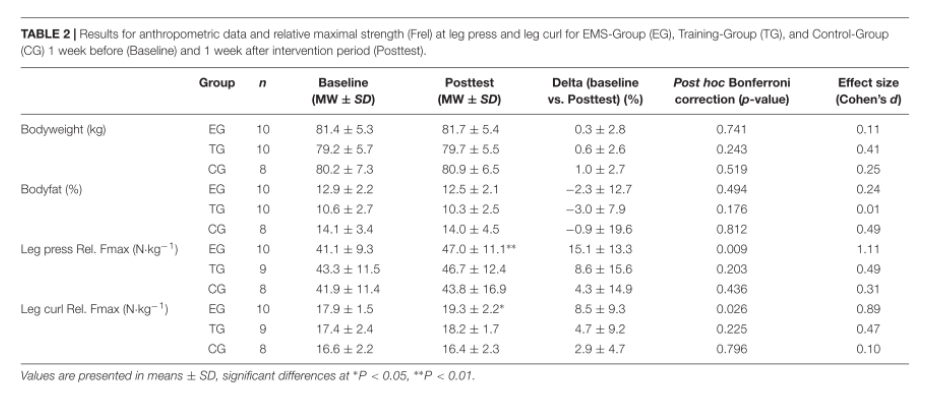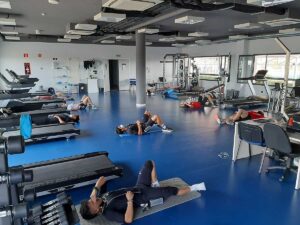Improving short-term physical performance in high-performance soccer players is of crucial importance. Therefore, ensuring a proper recovery after a match and the integration of effective strength programs to systematically increase football-relevant strength parameters during the competitive season is a demanding task for the coach. Due to the lack of time, the implementation of alternative training methods that offer highly efficient stimulation of muscle adaptation has an important value. Among those training methods we have electrostimulation (EMS) which has proven to be an effective alternative to improve maximum strength and specific strength capabilities such as jumping and sprinting in trained and elite team sports athletes (Delitto et al. , 1989; Maffiuletti et al., 2000, 2002a; Malatesta et al., 2003; Gondin et al., 2005; Billot et al., 2010; Filipovic et al., 2016). In a study with professional soccer players, significant increases in maximum leg press strength, jump and sprint were achieved with dynamic WB-EMS training after 7 weeks (14 sessions) (Filipovic et al., 2016) . However, the study failed to investigate skeletal muscle substructures; therefore, it is unclear whether that increase in maximum strength was caused by an increase in muscle size. Therefore, the objective of this study was to test whether EMS-induced strength gains are also associated with molecular and structural adaptations in skeletal muscle in high-performance soccer players, for which WB-EMS was applied in a training program. soccer force specific.
For the present study, 28 soccer players were assigned and randomly divided into three groups. EMS group (EG, n = 10) which performed 3 x 10 jump squats applying WB-EMS superimposed twice a week in addition to the regular soccer routine over a period of 7 weeks. On the other hand, to differentiate between the effects caused by EMS, jump squats and routine soccer training, two control groups were included. A jump training group (TG, n = 10) that performed the same volume of jump squats on the same days as the EG and another control group (CG, n = 8) that only performed the regular soccer routine.
The regular soccer routine consisted of performing 3-1 sessions per week of global tactical technical work and a 90 min game at the end of the week. On the other hand, the group with WB-EMS carried out the training sessions on Tuesdays and Fridays, leaving an interval of 48 hours of rest between sessions and the matches were played on Sundays. The type of wave that was used was a biphasic, rectangular and compensated wave, with a frequency of 80 Hz with a pulse width of 350 µs and an intensity of 0-120 mA. To regulate the intensity, the Borg scale was used, being strong 16 and very strong 19 over 20. The intensity of the training was defined for each player in a familiarization session 2 weeks before and the intensities were saved in a file. The EG group performed 3 x 10 maximum jump squats with a pause of 60 sg (no electric current) between sets. In each series, the jump was performed with an impulse of 4 seconds of work (2 sg eccentric phase of the 90º squat, 1 sg isometry, 0.1 concentric explosive phase and 1 sg of stabilization) and between repetitions 10 sg of rest.
The TG group performed the same number of jumps at identical intervals twice a week without WB-EMS.
When analyzing the anthropometric data, no changes were observed in body weight or body fat (Table 2). There were also no differences in training volume between the groups. Regarding the strength of the lower body, a significant improvement was observed in the EG group compared to the TG and CG group (Table 2). Finally, when analyzing muscle composition, there were no significant changes in the structure of type I fibers, however, if there were positive changes in the diameter of type II fibers in group EG and in group TG and CG, no gave significant changes (Table 3).


Conclusion
Analyzing the results, we conclude that the WB-EMS is a time-efficient tool for strength training and improving strength capabilities during the competitive season in soccer players. Also, you can emphasize the adaptability of fast Type II fibers. Therefore, the improvements it offers can be a great help when programming the competitive season for soccer players and it would be interesting to extrapolate it to other sports.
Informative note
This study does not specify whether study participants underwent prior adaptation to WB-EMS. Therefore, from Wiemspro we advise that before applying a WB-EMS training protocol, an adaptation period must be passed with a frequency below 50 Hz without reaching electrostimulation intensities that can cause high exhaustion for at least 6 -8 sessions.
Bibliography
- Andre Filipovic, Markus DeMarees, Marijke Grau, Anna Hollinger, Benedikt Seeger, Thorsten Schiffer , Wilhelm Bloch and Sebastian Gehlert.. (2019). Superimposed whole-body electrostimulation augments strength adaptations and type ii myofiber growth in soccer players during a competitive season. Frontiers in Physiology, 10, 1-11.
- Delitto, A., Brown, M., Strube, M. J., Rose, S. J., and Lehman, R. C. (1989). Electrical stimulation of quadriceps femoris in an elite weight lifter: a single subject experiment. Int. J. Sports Med. 10, 187–191. doi: 10.1055/s-2007-1024898
- Maffiuletti, N. A., Cometti, G., Amiridis, I. G., Martin, A., Pousson, M., and Chatard, J. C. (2000). The effects of electromyostimulation training and basketball practice on muscle strength and jumping ability. Int. J. Sports Med. 21, 437–443. doi: 10.1055/s-2000-3837
- Maffiuletti, N. A., Dugnani, S., Folz, M., Di Pierno, E., and Mauro, F. (2002a). Effect ofcombined electrostimulation and plyometric training on vertical jump height. Med. Sci. Sports Exerc. 34, 1638–1644. doi: 10.1249/01.MSS.0000031481. 28915.56
- Malatesta, D., Cattaneo, F., Dugnani, S., and Maffiuletti, N. A. (2003). Effects of electromyostimulation training and volleyball practice on jumping ability. J. Strength Cond. Res. 17, 573–579. doi: 10.1519/00124278-200308000-00025
- Gondin, J., Guette, M., Ballay, Y., and Martin, A. (2005). Electromyostimulation training effects on neural drive and muscle architecture. Med. Sci. Sports Exerc. 37, 1291–1299. doi: 10.1249/01.mss.0000175090.49048.41
- Billot, M., Martin, A., Paizis, C., Cometti, C., and Babault, N. (2010). Effects of an electrostimulation training program on strength, jumping, and kicking capacities in soccer players. J. Strength Cond. Res. 24, 1407–1413. doi: 10.1519/ JSC.0b013e3181d43790
- Filipovic, A., Grau, M., Kleinoder, H., Zimmer, P., Hollmann, W., and Bloch, W. (2016). Effects of a whole-body electrostimulation program on strength, sprinting, jumping, and kicking capacity in elite soccer players. J. Sports Sci. Med. 15, 639–648.







